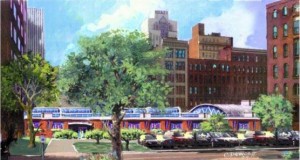
With its new $47 million public transportation system, the Rochester Genesee Regional Transport Authority hopes to decrease traffic. Construction is planned to begin late this summer on Mortimer Street. Courtesty of RGRTA.com
Although advertised as “the end to a very cold era by 2013,” the Rochester Genesee Regional Transport Authority’s (RGRTA) new $47 million public transportation center has ignited extensive controversy among the public and various activist groups at a series of public meetings since its initial proposal last June.
The completely enclosed center is seen as a solution to the throngs of traffic and parked public buses that currently plague Main Street in downtown Rochester.
Construction is set to begin late this summer on Mortimer Street between North Clinton Avenue, Pleasant Street and St. Paul Boulevard.
Funding for this ambitious project will be 80 percent in the form of grants from the Federal Transit Administration, 10 percent from NYS Department of Transportation funds and 10 percent in a contribution from the RGRTA.
In an online blog, many community members expressed concerns that a single-function facility is not the best use of resources given the current needs of Rochester, but the plan is nonetheless moving forward.
The idea for the RTS center was born from the ashes of the failed 2006 Renaissance Project, which sought to bring a cultural rebirth to the moribund downtown area through the construction of a satellite campus for Monroe Community College, a performing arts center and the RTS transit center.
Unfortunately, with a $230 million price tag, the plan was stymied by a lack of funds until its termination in 2009, leaving downtown both un-revitalized and with the perceived need for a central and cohesive transport center.
In June 2010, under pressure from Rochester’s business community and the City Council, the idea for the RTS center was resurrected. By eliminating on-street transfers, the center will lessen traffic on Main Street while leaving Mortimer Street open to one-way traffic and, therefore, expand business potential on the main corridor. The indoor facility will have a 30-bus capacity, a waiting area, vending kiosks, a ticketing area and restrooms.
“Although most transit centers are open air, the design criteria called for an enclosed facility, which was challenging to design, especially given such a narrow space to use,” Vice President of Communications at the RGRTA, Shelley Dinan said. “We are not knocking down buildings to build more.”
Despite the fact that the center will offer shuttles to Amtrak and the airport and that there will be a taxi stand a block away, residents expressed concern that such an exorbitant sum of money would be spent on a facility with only one function — Rochester public buses.
“I think it’s failed,” Rochester resident Rachel Edwards said at the final public review meeting held on Friday, Feb. 11. “I think they haven’t taken into account all of the methods of ground transportation. It’s designed as a single-use facility that’s the past. We need a facility that takes us into the future.”
In an attempt to look towards the future and make the new RTS center progressive and sustainable, the RGRTA has been working with the Rochester Cycling Alliance. According to its website, the RCA works to create better infrastructure for bicycles and a stronger voice for cyclists in Rochester through programming and volunteer outreach. The RGRTA has agreed to include 20 bike lockers in the final design plans so that commuters may leave their bikes safely before boarding a bus. Though a victory, Bill Collins, representative of the RCA, raised the issue at the February public meeting that no plans exist for a publicly accessible walkway between the lockers and the center.
Dinan stressed that every effort has been made on the part of the RGRTA to listen to the public’s comments, adding that, “There will always be people with negative opinions.”
City officials hope that the building will create a safer environment for teenagers to wait indoors instead of loitering on the streets while they wait for a bus — a nagging issue for businesses on Main Street.
“We’ve worked extensively with members of the handicap disability community — we will be implementing some fairly progressive amenities that will make movement through the center as smooth as possible for those in wheelchairs and for those who are visually and hearing impaired,” Dinan said.
In an effort to placate public concern about the shortcomings of the center, efforts are being taken to ensure that its architecture parallels that of the surrounding community and that glass is amply used on the outside in order to create a feeling of openness and light.
Although the public raised some concerns about a completely glass exterior, the RGRTA believes that the glass will make the adjacent Mortimer Avenue less dark and foreboding to walk down. The building is also being constructed to adhere to certain environmental standards.
Although limited to one form of transportation, the RTS center will provide enhanced services to UR students traveling from the Eastman School of Music to the River Campus, as this bus line will transfer through the new center.
The center will ease travel in inclement weather by providing a sheltered place to wait, make transferring downtown on public transportation more expedient and provide a central location for University students needing to access the airport or Amtrak trains.
Since the last opportunity for public dialogue has passed, the RGRTA anticipates that final design plans will be completed within a month, construction will commence in late summer 2011 and the center will be open for use in fall 2013.
Buletti is a member of
the class of 2013.


